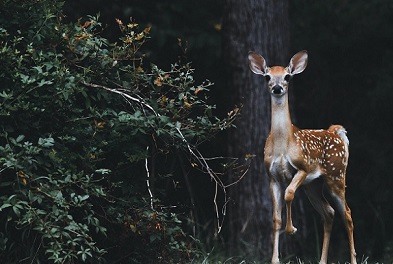
NATIONAL REPORT—Golf courses have always been intertwined with nature. But of late, golf course architects are becoming more aware of the effect of designing and building a course on the surrounding environment, and they’re creating courses that meld harmoniously with the surrounding landscapes.
Wildlife conservation on golf courses is becoming a bigger topic by the day. These beautiful, natural spaces can serve a dual purpose with a bit of focused effort behind the scenes. And with organizations like Audubon coming on board, golf courses are no longer simply a field for sports. They’re becoming havens for biodiversity.
The best thing about this shift towards conservation is that it changes nothing for the golfer. Anybody can step onto a golf course, modern or historic, and play an enjoyable round of golf without being affected by the measures taken to boost eco-friendliness—but you might be lucky enough to spot a bit of wildlife on the course itself.
The Evolution of Golf Courses
When golf courses were first designed and built, there wasn’t as much consideration for the environment. Once a site had been scoped out and chosen for a golf course, huge mounds of earth were excavated and dumped in other places to create the shape the architect wanted for the course.
Thousands of gallons of water went towards watering the fairways and greens, and pesticides were freely used to prevent damage by critters. There is no malice here—it’s just how it always was.
Until recently. There’s been a definite shift in recent years towards more sustainable practices in general, and golf courses started taking a hard look at their own processes to see where positive changes could be made.
And so, the emergence of environmentally conscious golf courses has changed the way things are done in the industry, from golf course design to management. Even playing the game now has a sustainable edge to it, with golfers able to wear sustainable apparel and even use eco-friendly equipment.
Biodiversity in Designing Golf Courses
Golf course sustainability begins in design. Golf course architects are considering biodiversity and the natural lay of the land upfront, and instead of changing the land to accommodate a golf course, designing the golf course to fit in seamlessly with the existing terrain.
Architects need to consider wildlife habitats within the course layout, creating safe corridors for wildlife to move through, installing things like nesting boxes, and ensuring that native plants are given the space they need to flourish.
The safety of the flora and fauna is of optimal importance, so golf course designers also need to keep in mind the natural boundaries within the area to prevent golfers from inadvertently encroaching on their habitats.
Golf architects have risen to the challenge of creating and implementing more eco-friendly courses that meet the needs of both the golfers and the wildlife who were there before the humans were.
How Golf Courses are Becoming More Environmentally Friendly
Once the golf course has been designed to accommodate the natural flora and fauna, it’s up to the golf course managers to implement sustainable practices so the course continues to be eco-friendly.
Some of these measures are directly related to caring for the wildlife on the property, while some are more general sustainability measures for the environment. Wildlife- and nature-related action points may include:
- Planting more native trees and plants;
- Creating more bodies of water;
- Leaving rough areas unmowed;
- Installing nesting boxes;
- Avoiding the use of pesticides; and
- Creating off-limits areas for golfers.
More general measures to improve the golf course’s eco-friendliness could include:
- Collecting rainwater and recycling it for irrigation purposes.
- Choosing energy-efficient options where possible.
- Recycling waste from the clubhouse and restaurants.
- Composting organic waste and using it instead of fertilizers.
- Opting for solar-powered golf carts rather than electric or gas.
- Promoting biodiversity and educating golfers about its importance.
Promoting Sustainable Golfing
Promoting the sustainable side of golf courses and the sport, in general, is the responsibility of everyone involved in the sport. Golf course managers need to take the initiative, especially if their golf course isn’t already implementing eco-friendly measures.
Turning a golf course into an environmentally friendly facility doesn’t happen overnight. Some things can be actioned more easily than others, like switching to energy-efficient light bulbs or composting natural waste and using it as fertilizer.
Others might take years, many meetings, and budget changes to implement. But the rewards far outweigh the effort it takes to get there. Eco-certified golf courses attract attention from golfers who are interested in sustainability, and it gives your course an uptick in terms of credibility and ethos.
Marketing campaigns with a slant toward raising awareness about the environment and golf’s role in protecting it can go a long way toward making golfers aware of the measures you’re taking.
Encouraging Your Golfers
If you’re making the effort to create a more eco-friendly course, a huge part of that is encouraging your golfers to follow suit. One of the easiest things you can do is encourage them to embrace eco-friendly behavior when they’re on the course, like respecting the flora and fauna, keeping the noise down, and walking the course where possible.
You can also get your pro shop involved here. When it comes to golfing equipment and apparel, the market is currently filled with new, innovative products that are as sustainable as they are stylish.
You can stock your pro shop with sustainable golfing apparel and things like biodegradable tees, which some golfers aren’t even aware of. Make your golfers aware of the difference they can make while they’re playing, and facilitate their sustainable journey too.
Conclusion
The rise of eco-friendly golf courses is exciting to see. It’s positive for golfers, creating awareness around wildlife conservation and changes they can make to become more sustainable with their own game.
But it’s positive for the sport overall, as well. Mixing golf and biodiversity is a match made in heaven if done right. We encourage golfers to explore eco-friendly golf courses and see how they can change their own game to become more environmentally friendly.
And if you’re a golf course manager or golf architect, it’s absolutely worth investing in eco-friendly measures. It’s not just good for the environment, it’s a mark of honor on your golf course.
About the Author
Jordan Fuller is a retired golfer and businessman. When he’s not on the course working on his own game or mentoring young golfers, he writes in-depth articles for his website, Golf Influence.






